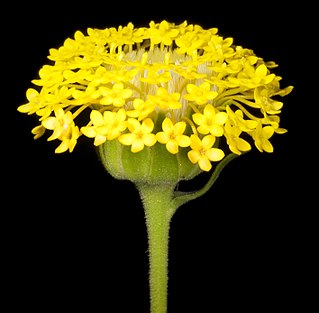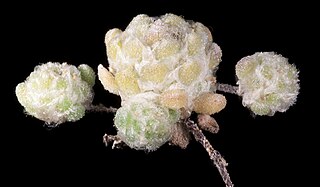
Leucophyta is a plant genus which is endemic to Australia. The genus was first formally described by botanist Robert Brown in 1818.
Chthonocephalus is a genus of annual herbs in the family Asteraceae. The genus is endemic to Australia, with species occurring in all mainland states.

Actinobole is a genus of dwarf annual herbs in the family Asteraceae described as a genus in 1843.

Podotheca is a genus of flowering plants in the tribe Gnaphalieae within the family Asteraceae. All species are endemic to Western Australia, except for Podotheca angustifolia which occurs across the south of Australia.

Minuria is a genus of annuals, perennials and dwarf shrubs in the tribe Astereae within the familyAsteraceae.
Millotia is a genus of small annual herbs in the tribe Gnaphalieae within the family Asteraceae.

Trichanthodium is a genus of Australian plants in the tribe Gnaphalieae within the family Asteraceae.

Dithyrostegia is a genus of Australian flowering plants in the family Asteraceae.

Hyalochlamys is a genus of Australian flowering plants in the family Asteraceae.
Sondottia is a genus of Australian plants in the tribe Gnaphalieae within the family Asteraceae, first described by Philip Sydney Short in 1989.

Pogonolepis is a genus of Australian plants in the tribe Gnaphalieae within the family Asteraceae.

Asteridea is a genus of flowering plants in the family Asteraceae. Evidence suggests that the genus, Asteridea, is monophyletic.

Alexgeorgea is a genus of three plant species found in Western Australia belonging to the family Restionaceae named in honour of the botanist Alex George in 1976. The flowers of the female and large nut-like fruit are completely underground except for the stigmas, which extend out of the ground as 3 purple or red threads.
Dielitzia is a genus of flowering plants in the family Asteraceae described as a genus in 1989 by Philip Sydney Short.

Fitzwillia is a genus of flowering plants in the family Asteraceae described as a genus in 1989.
Lemooria is a genus of flowering plants in the family Asteraceae described as a genus in 1989.

Blennospora phlegmatocarpa is a herb species in the family Asteraceae. It is found in Western Australia.

Pembertonia latisquamea is a species of daisy (Asteraceae), native to Western Australia. It was first described by Ferdinand von Mueller in 1878 as Brachyscome latisquamea and transferred to the genus, Pembertonia in 2004 by Philip Short.

Hullsia is a genus of flowering plants in the family Asteraceae. It only contains one species, Hullsia argillicola.

Roebuckiella is a genus of flowering plants in the sunflower family, Asteraceae. It includes nine species native to Australia. Seven species are endemic to Western Australia, and two are native to New South Wales, Queensland, and Western Australia.














